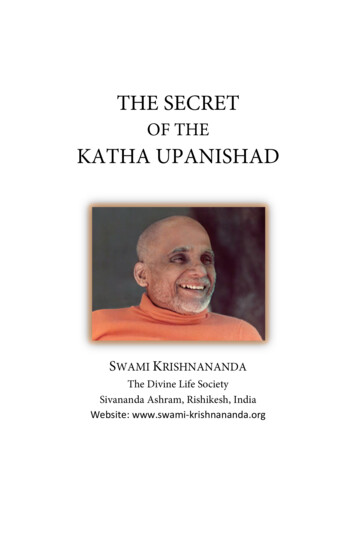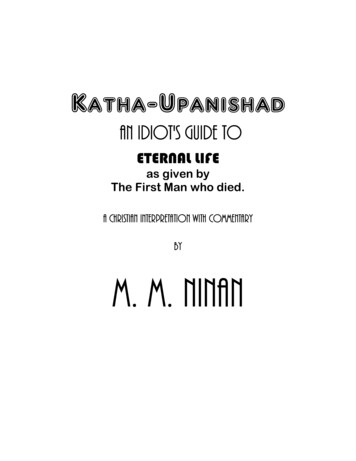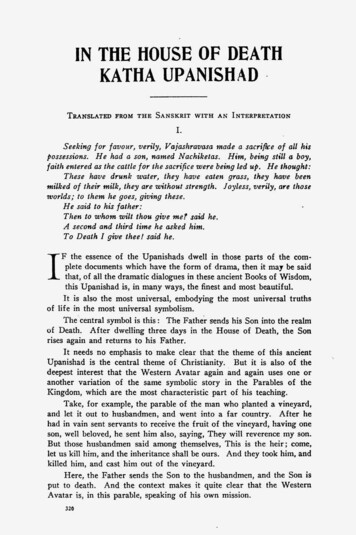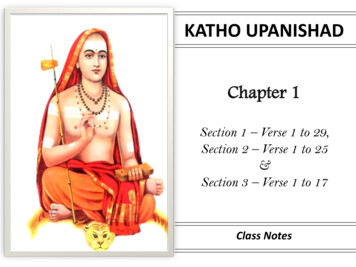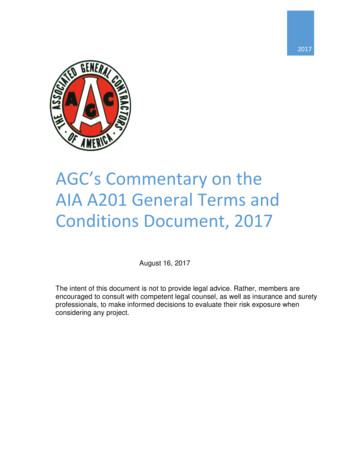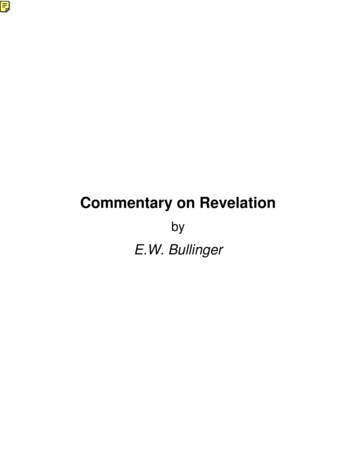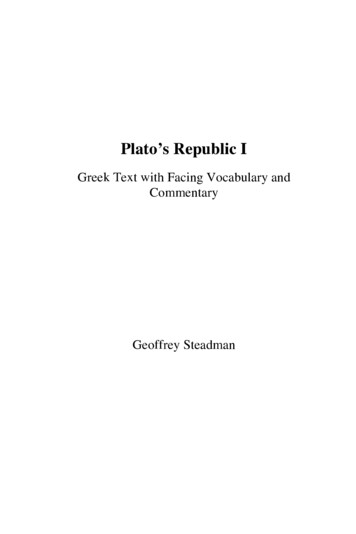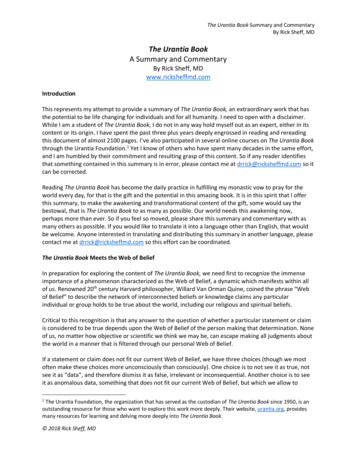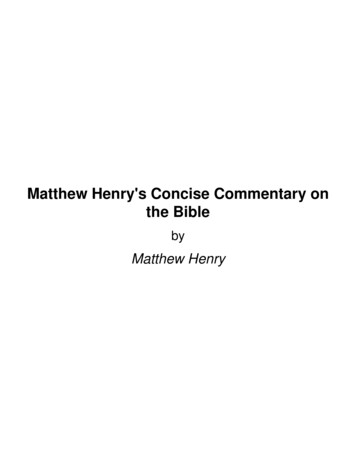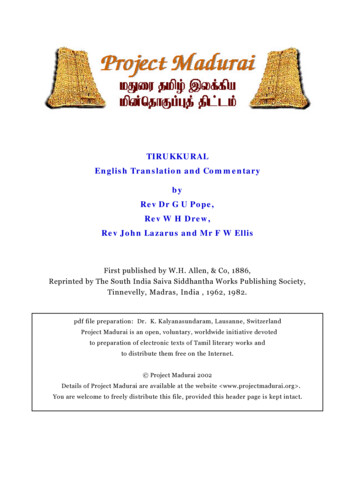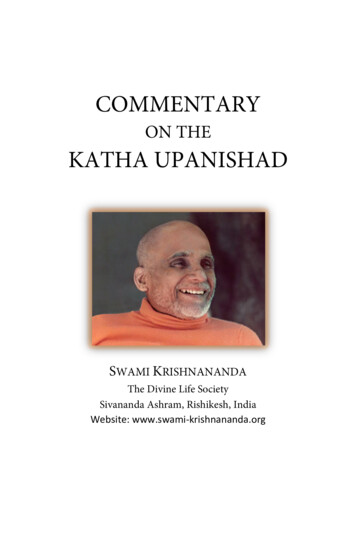
Transcription
COMMENTARYON THEKATHA UPANISHADSWAMI KRISHNANANDAThe Divine Life SocietySivananda Ashram, Rishikesh, IndiaWebsite: www.swami-krishnananda.org
ABOUT THIS EDITIONThough this eBook edition is designed primarily fordigital readers and computers, it works well for print too.Page size dimensions are 5.5" x 8.5", or half a regular sizesheet, and can be printed for personal, non-commercialuse: two pages to one side of a sheet by adjusting yourprinter settings.2
CONTENTSCHAPTER 1. 9SECTION 1 – NACHIKETAS’ POSITION . 9Prologue: Nachiketas Devoted to Death .9Nachiketas in the House of Death . 12Three Boons Offered to Nachiketas . 13Nachiketas’s First Wish: Return to an Appeased Fatheron Earth . 15Nachiketas’s Second Wish: Understanding of theSacrifical Fire . 16Nachiketas’s Third Wish:. 21Knowledge Concerning the Final Death . 21SECTION 2 – THE EXISTENCE OF THE SUPREME BEING. 27The Two Ways: The Good and the Pleasant . 27The Requirement of Steadfast Renunciationand Meditation. 40The Eternal Indestructable Soul. 51The Opposite Characteristics of the Supreme . 54The Conditions of Knowing Him . 55SECTION 3 – SADHANA. 61Two Selves: The Universal and Individual Soul . 61The Nachiketas Sacrificial Fire as an Aid . 64Parable of the Individual Soul in a Chariot . 65Intelligent Control of the Soul's Chariot Necessary. 67The Order of Progression to The Supreme . 70The Method of Yoga . 78Exhortation and Call to the Way of Liberation from Death . 85The Immortal Value of this Teaching . 923
CHAPTER 2. 93SECTION 1 – THE INTRICACIES OF THE INNER WAYOF THE SPIRIT. 93The Self is Not to be Sought Through the Senses . 93Yet the Agent in All the Senses in All Conditions. 98The Universal Soul is Identical with the Individual Soul . 103Failure to Comprehend the Essential Unity of Being is theCause of Rebirth . 112The Eternal Lord Abiding In One's Self . 116The Results of Seeing Diversity or Unity . 120SECTION 2 – THE STAGES OF SELF-CONTROL . 123The Real Soul of the Individual and Creation . 123The Appropriate Embodiment of the Reincarnating Soul . 132One's Real Self, the Same as the World-Ground. 136The Self is Both Immanent and Transcendent . 138Indescribable Bliss of Self-Realisation. 140The Self-Luminous Light of the World. 146SECTION 3 – THE TREE OF LIFE . 147The World-tree Rooted in Brahman . 147The Great Fear . 152Degrees of Perception of the Self . 156The Gradation Up To the Cosmic Being. 160The Method of Yoga . 163The Self is Existence . 167Requires Sincere Renunciation of All Desires andAttachments . 172Seeking the Self. 174This Teaching: A Way to Immortality . 178The Katha Upanishad by Sri Swami Sivananda (SanskritVerses, Transliteration and Translation . 1804
SHANTI MANTRAEvery Upanishad commences with a prayer, the ShantiMantra; a formula for the invocation of peace, chanted atthe beginning and close of study. The Shanti Mantra of theKatha Upanishad reads:auṁ saha nāvavatu, saha nau bhunaktu, saha vīryamkaravāvahai; tejasvi nāv adhītam astu: mā vidviṣāvahai; auṁśāntih, śāntih, śāntih.It means that there should be proper attunementof spirit between the Guru and disciple before they beginthe study, for only then will the teaching be fruitful:“May we both be protected. May both of us be taken careof properly. May we study together. May our teachingand learning be resplendent. May there be nomisunderstanding between us. May there be no discordof any kind. May there be peace, may there be peace,may there be peace.” Thrice peace; we have threekinds of troubles, called tapatraya: internally, physicalones; externally, from outside beings; and from above,given by the gods. May all these cease.5
INTRODUCTIONThe Bhagavadgita is a part of the Mahabharata epic.The purpose of this epic is to spread esoteric knowledge tothe public—a knowledge which is difficult to get. TheMahabharata is a Smriti, which implies an easy rendering ofa complex and esoteric text. Smriti is a text which iswritten, and not revealed, like the Shruti is. The Vedas are arevealed text and not written by any author.As mentioned in one of the Gita Mahatmya verses, theBhagavadgita is the essence of the Upanishads. Why was itnecessary to give the essence? Because Kaliyuga was aboutto dawn, and truths which could be understood before nowneeded elaborate explanations, as people’s minds hadbecome unfit to understand the subtleties of theShrutisHence, it is profitable to behold the esoteric andmystical meaning of the Bhagavadgita. A truth not to begiven to the masses, but only to initiated disciples. It is notthat knowledge is to be hidden, but it should be avoidedbeing given into wrong hands.There is a scripture similar to the Bhagavadgita in manyrespects, called the Katha Upanishad, the one from whichthe Bhagavadgita-teachings are believed by many to havebeen drawn. If the Bhagavadgita is a conversation betweenSri Krishna and Arjuna, placed in the context of thehistorical event of the Mahabharata war, the KathaUpanishad is a conversation between Yama andNachiketas. Just as we have the confusion of Arjuna’s mindin the beginning of the Bhagavadgita, we find intenseaspiration on the part of Nachiketas in the beginning of theKathopanishad. There are four important stages in its6
teaching, even as the eighteen chapters of the Bhagavadgitareveal the stages of the sadhaka’s evolution.The Katha is magnificent in its poetic beauty andmystical value. It touches the vital points of spiritualitywithout beating about the bush. The verses or mantras arestatements of human consciousness in its higher reaches ofthe spirit. This Upanishad takes an anecdote for itsbackground. It occurs in the Taittiriya Brahmana portion ofthe Vedas which precedes the Kathopanishad:Vajasravasa Gautama performed a sacrifice calledSarvavedas or Sarvadakshina, a sacrifice in which one issupposed to offer everything he has, without exception;hence its name Sarvadakshina. It is a preparation for thelast stage of spiritual life. However, he was not really readyfor it. He wanted to offer only things which were not useful,thus following the letter of law, but losing the spirit behindit. He had a young son, Nachiketas by name, who clearlysaw the two defects in the sacrifice: the giving of weak andbarren cows, and the father’s ignorance of the fact that theson, too, was to be offered. “Joyless,” said the boy, “are theregions to which he goes who offers such sacrifices!” thusirritating his father. And he asked him: “To whom are yougoing to offer me?” He repeated this question thrice, andthe displeased Gautama answered angrily: “To death I sendyou!”Here ends the outline of the story, and now we have thereal beginning of the Upanishad—a direct teaching to thespiritual aspirant.The Vedas contain four sections: the mantra portioncalled the Samhitas; the ritualistic portion called theBrahmanas (external sacrifice to the chanting of the7
Samhitas); the internal ways of sacrifice, the Aranyakas—which can also be called internal Brahmanas—which aresacrifices without involving materials; and the endportionof the Vedas, the Upanishads, also known as Vedanta.8
CHAPTER 1SECTION 1 – NACHIKETAS’ POSITIONPrologue: Nachiketas Devoted to Deathuśan ha vai vājaśravasaḥ sarva-vedasaṁ dadau:tasya ha naciketā nāma putra āsa. (1)“Desiring heavenly enjoyment, Gautama performed asacrifice called sarva dakshina. He had a son, Nachiketas,very thoughtful and discriminative.”Desiring did he perform the sacrifice. The intentionbehind it was to gain heavenly pleasure. This represents thepurely exoteric aspect of religion, the outward form ofdevotion and faith as different from the internal spirit orthe esoteric significance of practice. While Gautamarepresents the outer form of religion, Nachiketassymbolises the inner spirit. The former attitude expectssomething from every religious act: ‘What shall I get frommy pilgrimage, from a sacred bath, etc.?’ These are thequestions of this mind. ‘If I will not get something, I willnot be religious’. This attitude exhibits a commercialattitude leading to bigotry. While the outer form isnecessary—like the legs of a person who can walk withthem but needs a head to think with—it is inadequate byitself. The spirit should go hand in hand with the form. So,religion is different from spirituality, though it is verynecessary. The outer form of worship should be anexpression of inner surrender, and not a mere symbol. Thisis what Gautama’s sacrifice lacked. Desiring something heperformed the sacrifice, but did not part with everything he9
had, as was required by its spirit. When this dakshina wasgiven by him, Nachiketas thought to himself:taṁ ha kumāraṁ santaṁ dakṣiṇāsu nīyamānāsu śraddhāviveśa, so’manyata. (2)Is this religion? He was a great spiritual example for alltimes to come, though his question was impertinent. Hethought: “What is this sacrifice?”pītodakā jagdha-tṛṇā dugdhadohā nirindriyāḥanandā nāma te lokās tān sa gacchata tā dadat. (3)He wants the pleasure of this world, so he did not partwith the good cows; and he also wants the pleasure in theother world, so he gives (useless) cows. It is a poor sacrifice,because he offers that which is unworthy.sa hovāca pitaram, tāta kasmai māṁ dāsyasīti;dvitīyaṁ tṛtīyam; taṁ hovāca: mṛtyave tvā dadāmīti. (4)In the fourth mantra, the teaching proper commenceswith: sa hovaca pitaram. “To whom do you propose tooffer me?” The ‘me’ represents also the self of Gautama. If itis offering all, sarvadakshina, then it should include notonly what belongs to one, but also his own self. Three timesasked Nachiketas this question. The answer was, “Untodeath I offer you.” Though this was the answer to the son, itmystically means the death of the soul.Three times asked the boy, implying the ‘I’ has to begiven up in three stages, not at once. The first one is thephysical offering, followed by the subtle and the causal,because we are this threefold being; we can also call itconscious, subconscious and unconscious. We are citizensof three worlds; this is brought out when one takes sanyasa.The seeker takes an oath that he renounces the pleasures of10
this world, of the astral world and of the heavens—all thethree worlds. The offering has to be total and all-inclusive.Psychologists call this condition introversion, and it is selfabnegation in ethics. So Nachiketas’ thrice-repeatedquestion has spiritual import of the necessary threefoldoffering of every seeker. This is like dying, for who can offerhis whole being to God? We cannot even offer our physicalpossessions. To offer the mind and the subconscious isveritable death. The threefold personality has to passthrough veritable death, and this is rebirth, as it were, intothe awakening of the spirit. It is rebirth in the spirit, anddeath to all that is physical. “Let the ‘me’ be offered in itsthreefold significance!” is the outer and inner meaning ofthe mantra.bahῡnām emi prathamaḥ, bahῡnām emi madhyamaḥ;kiṁ svid yamasya kartavyam yan mayādya kariṣyati. (5)It is the darkness of not-knowing that is spiritual death.Nachiketas thought: “What is the business of Yama that isbeing achieved through me? Why should I go to him? Ihave served my father well. I may be the first or at least thenext, but not the worst. What is the intention of his offeringme to Yama?”anupaśya yathā pῡrve pratipaśya tathāpare,sasyam iva martyaḥ pacyate sasyam ivajāyate punaḥ. (6)“Well, whatever you have said is all right,” he said toGautama, and added: “Don’t withdraw your words.Remember our ancestors who have adhered to truth always.Let it be so, although it may be unpleasant. Though youmight have unwittingly, in anger, said it, don’t take it back.Like a corn in the field does a human being grow and fall:11
the
Katha Upanishad reads: auṁ saha nāvavatu, saha nau bhunaktu, saha vīryam karavāvahai; tejasvi nāv adhītam astu: mā vidviṣāvahai; auṁ śāntih, śāntih, śāntih. It means that there should be proper attunement of spirit between the Guru and disciple before they begin the study, for only then will the teaching be fruitful: “May we both be protected. May both of us be taken care .
